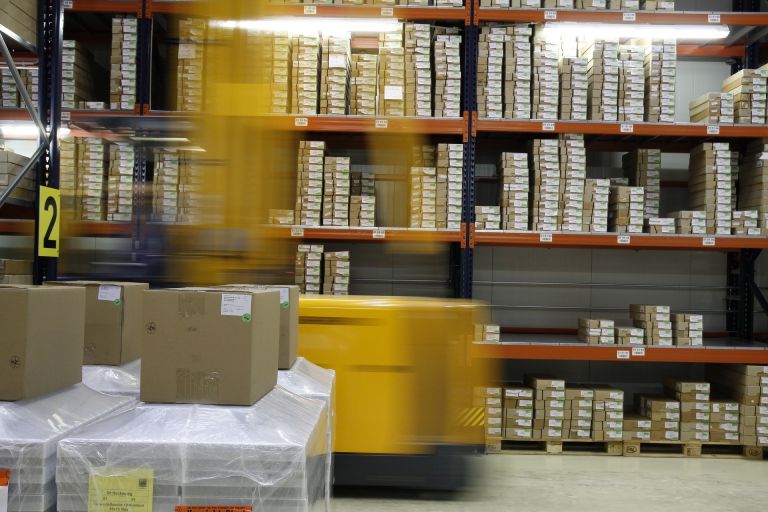Nothing is more frustrating than supply chain interruptions, which could be due to several factors like damaged product delivery, manufacturing delays, order delivery delays or unexpected events. While some of these factors are beyond control, there are several of them that can be traced back to inefficient supply chain management and the efficiency of inventory flow from manufacturer to retailer to end user. Especially with the increasing popularity of omni-channel retail, complete control of its hierarchical, dynamic and complex distribution ecosystem has become necessary. Here, we will introduce distribution management, how it works, and how to use 3PL partners to improve distribution.
What Is Distribution Management?

Distribution management refers to monitoring the movement of finished products from the manufacturer or supplier to the end user, including packaging, and last mile delivery. Well-executed distribution management can help improve order fulfillment processes, inventory turnover, profit margins, supply chain agility, and ultimately increase customer satisfaction.
Importance Of Distribution Management For E-Commerce?
The goal of distribution management is to keep inventory flowing throughout the supply chain. The efficiency of the implementation of distribution management will affect the profit margin and the growth rate of the brand. For example, if you spend too much on storage, you may have accumulated too much dead stock. Or, if you don’t replenish your inventory quickly enough, it may result in lost sales as your products will probably go out of stock. If done well, distribution management is one of the most sensible ways to ensure:
- Inventory is effectively allocated and reaches customers in the fastest and most efficient way.
- There is enough inventory to meet demand while optimizing storage costs.
- Businesses have sufficient visibility to make improvements and take informed decisions.
There are 4 important channels of distribution management:
- Wholesalers: Wholesalers provide raw materials or finished products in bulk at low prices, which can be sold to manufacturers, distributors or retailers. Wholesalers are often involved in the distribution of raw materials used to manufacture finished products.
- Distributor: The distributor acts as an intermediary between the manufacturer and the wholesaler or retailer. When manufacturers want to increase their regional distribution, they authorize distributors (from the local market) to sell their products. Usually, these distributors also provide warehousing and logistics support, given their grip in the local market.
- Retailers: Retailers can choose to work directly with wholesalers, manufacturers or suppliers. Major retailers often distribute products from different suppliers through different sales channels to reach their end customers. Example, Carrefour sources products from multiple and different brands and sells it online and in their physical stores.
- E-commerce: E-commerce has paved the way for modern direct-to-consumer brands (DTC) that deliver products directly to end users (in their chosen location – home / office). Online retailers work with manufacturers and suppliers to order inventory and store it in warehouses. Once an order is placed, items are picked and packed from the available inventory, and shipped directly from the warehouse under the company’s name. E-commerce compliance has removed middlemen from distribution, providing faster delivery, affordable prices and better customer service.
How E-commerce Distribution Management Works?
When monitoring inventory movements throughout the supply chain, there are several moving parts. Every activity that occurs during distribution management is critical, let’s take a closer look at what actions have taken place throughout the process.
Inventory receiving:
When e-commerce inventory arrives at the warehouse or fulfillment center, it will be unloaded, processed, and stored. Proper warehousing receiving is important for efficient supply chain setup, inventory management and offering a good fulfillment experience. At this stage, it is important to carefully check the inventory count to ensure that the products delivered by the manufacturer match the products ordered. Without proper inventory receiving procedures, you may be at risk of poor inventory accuracy or loss of inventory, which can affect profitability and inventory reporting.
Warehouse management:
Once the inventory is received, it needs to be monitored to ensure that there is enough inventory to meet the demand. Warehouse management refers to tracking and storing inventory, as well as training and managing warehouse personnel how to better monitor the inventory. The rise of digital warehousing has made it standard to implement a warehouse management system (WMS), which is designed to simplify warehouse processes, including warehouse inventory management. This reduces the need for manual labor, allowing warehouse personnel to focus on speed without compromising accuracy.
Order Packing:
Once all the items in a single order have been picked, the packing process begins. The packaging is more complicated than you think. It needs to put the right items together with the right packaging materials into the right-sized boxes to ensure that they arrive at their final destination in the most cost-effective manner, intact and undamaged.
Shipping:
This is the final step of the process where the order package is shipped to the final destination. For direct-to-consumer (DTC) brands, it is usually the end user, but some companies also provide B2B e-commerce services to deliver goods to another company.
E-commerce delivery is an important stage in the distribution process because it plays a key role in customer satisfaction. Having an appropriate shipping strategy ensures that you provide customers with competitive and profitable shipping options.
Benefits of Distribution Management System
Now that you understand the working principle of distribution management, let us understand the benefits of adopting an integrated distribution management system.
- Fulfill Orders As Soon As Possible – When you’ve just started out, in-house fulfillment can be managed because the number of orders to be fulfilled is small. But as you grow, adopting multi-channel distribution becomes vital in order to remain competitive and attract more customers. There are two components that can speed up the fulfillment process effectively: technology and location.
- Technology can help greatly improve the fulfillment process. Having the right technology stack can also improve inventory visibility across the distribution network, so you can better respond to unexpected situations and make better business decisions.
- Location is another important component that helps in improving the fulfillment process. Choosing warehouse and distribution centers closer to your customers and closer to major ports saves time and optimizes transportation by reducing costs and speeding up transportation time.
- Meeting Customer Expectations: Distribution management is essential to consistently meet customer expectations. With a distribution management system, you will never miss the opportunity to bring the manufacturer’s products to the end customer. Technology can be used to ensure that orders are delivered reliably and quickly over and over again at the right cost. It also ensures the availability of SKUs for each sales channel and the time required by customers. At the same time, it keeps order fulfillment costs low so that retailers can pass on the cost savings to customers.
- Handling Market Seasonality: Depending on the type of product you sell, seasonality can play an important role in distribution. “Seasonal” brands provide products related to a specific time period, event or season, and generate different demands according to different demand levels. At this moment. Proper distribution management can support seasonal brands by collecting historical sales data and determining the amount of available inventory in a specific time period (called forecasted demand). Adjust inventory levels and allocate inventory accordingly.
- Better Analysis Of Distribution Management Data: In order to improve and optimize your distribution network, you need a suitable system to collect and analyze supply chain data. By optimizing everything from inventory turnover, warehouse allocation, and current SKU-level inventory at each location, you can gain insights into how to better allocate products and optimize inventory throughout the network.
- Increase Profit Margins: In order to reduce operating expenses, a full understanding of the operating conditions (so that you can optimize your distribution strategy) can result in significant cost savings. Simply using more locations (probably from 3PL) to store inventory can help you save shipping costs during meetings
- Faster Delivery: A well-defined distribution system will enable you to offer better shipping options and incentives to your customers, which in turn will result in higher customer satisfaction at lower cost.
How ProConnect Integrated Logistics Can Help?
ProConnect Integrated Logistics is a 3PL service provider with expertise, infrastructure and technology system that provides best-in-class distribution management for your business. Our warehousing, fulfillment and distribution systems help with inventory receiving, real-time tracking, faster fulfillment TAT and shipping. By choosing us as your logistics partner, you can rely on our vast network, warehouse infrastructure, robust WMS and top class customer service – that would in turn help you improve your supply chain efficiency.
To know more about how we can help, drop in your enquiry.





 APP DOWNLOAD
APP DOWNLOAD